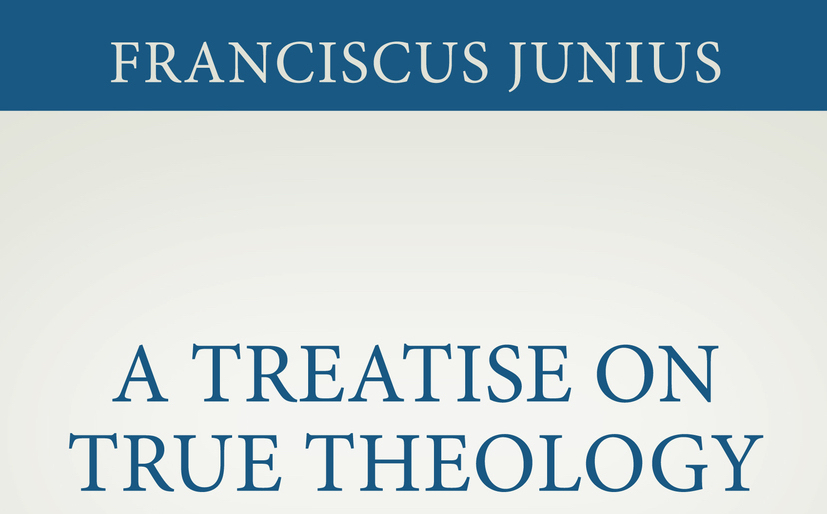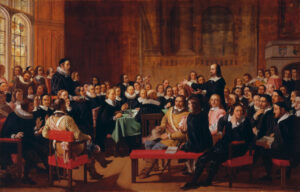Franciscus Junius, A Treatise on True Theology with the Life of Franciscus Junius. Translated by David C. Noe. Grand Rapids: Reformation Heritage, 2014. $40.00. Hardback. lii + 247 pp. 978-1601783417.
Reviewed in the Westminster Theological Journal 78 (2016), pp.181-4.
This edition of Franciscus Junius’s (1545-1602) A Treatise on True Theology is more than a first-rate translation of Junius’s most famous work. It includes a fantastic introduction by the late Willem van Asselt (which, by itself is worth the cost of the book), an illuminating forward by Richard Muller, a helpful summary of his English translation of the Latin original by David Noe, and a preface to Junius’s autobiography by Junius’s contemporary Paul Merulla, in addition to Junius’s autobiography and treatise. Franciscus Junius is best known for being one of the early respondents to Arminius’s controversial views on predestination and for warning Franciscus Gomarus on his deathbed not to appoint Arminius to succeed him as Professor of Divinity at Leiden (pp.ix and xix). It is a less-known fact that Junius’s Treatise was the first classic treatment of Reformed prolegomena that provided a rationale for systematically organizing dogma and that set forth-theological discourse ‘as fundamentally a relational enterprise’ founded on ‘the divine-human relationship’ (p.xxvi). Its significance was such that generations of Protestants borrowed from it, sometimes verbatim, in their works (p.ix). Its full significance is only grasped when read in the context of Junius’s 5000-page collected works, the Opera Theologica, published in Geneva (1607, 1613) and Heidelberg (1608) and later edited by Abraham Kuyper (p.xv).
In Junuis’s sixty-five-page autobiography we learn that he was one of nine children (p.16), that he almost died at birth (p.17), that he had a life-long ailment in his foot (p.18), and that at thirteen he wanted to study law (p.25). During his youth he was plagued by sexual temptation and for a time strayed from his Christian faith (pp.26-28). Nevertheless, it was through his father’s gentle encouragement (p.33) that he eventually read a New Testament that his father gave him and was drawn back to the Christian faith (p.34). At that point, he left his father’s home and moved to Geneva to learn the biblical languages (p.35) during Calvin’s final years (1562-1565) (p.xii). His first major trial came when he was unable to receive his father’s financial support on account of the French Wars of Religion. Nevertheless, God eventually provided for his financial needs through an encounter with William Burdo—a man from Bourges, Junius’s birthplace (p.39). Eventually, he travelled to Switzerland and linked up with leading Reformers Peter Martyr, Heinrich Bullinger, and William Farel (p.37). In 1573, at the request of Frederick the Elector, he relocated to Heidelberg to work with Emmanuel Tremellio on a translation of the Old Testament (p.69). This work, Sacra Biblia (1579), included Beza’s Latin translation of the Greek New Testament (p.xiii). Junius’s career ended at Leiden University, where he died on October 23, 1602 at 57 of the Black Death (p.xiv). His funeral sermon was preached by Francis Gomarus.
Turning to the Treatise itself, Junius’s scholastic methodology and exegetical approach are evident in the way that he lays out theological loci with clarity and precision. The work revolves around asking the three classic questions of scholastic method: ‘An sit? (Whether it is?), Quod sit? (What is it?), Qualis sit (Of what sort is it?)’ (p.xxvi). He uses Aristotelian aetiology, which has misled scholars to conclude that Junius (and other scholastics) diverted from the more biblical, as opposed to systematic, approach of the Protestant Reformers. This thesis has been overturned by recent scholars—most notably Richard Muller, Carl Trueman, and Heiko Oberman—who argue that the Scholastics’ use of ‘causal language’ was merely ‘a heuristic tool designed to ground a whole series of issues [in] theological epistemology’ (p.xxxvi). Junius’s work drew on a variety of traditions—patristic, medieval, and Reformed (p.xlvi). Moreover, his approach was not only Christological and Trinitarian—especially in his treatment of archetypal and ectypal theology (see pp.xlvi and 129-30)—but his primary aim was to apply doctrinal truths so that his readers might ‘know’ Christ and ‘worship Him’ (p.xlii).
The work itself is thirty-eight chapters long and comprises thirty-nine theses (pp.85-90). The first two theses take up how one knows that theology exists. Junius argues that ‘if we ourselves examine our own persons…there will be nothing in us which does not show that theology exists’ (p.94). Junius then fleshes out the distinction between true and false theology (Thesis 3) and contends that true theology ‘is the highest wisdom’ (p.99) and ‘the queen of the sciences’ (p.101). For Junius theology is first and foremost sapientia (wisdom) because ‘it makes judgments about the first principles and conclusions’ (p.101).
Perhaps the most insightful section of the work is Junius’s distinction between archetypal theology, ‘the wisdom of God himself’, and ectypal theology, that which is ‘fashioned by God’, (Thesis 4; p.104). Van Asselt notes that Junius adopted this distinction from ‘the orthodox fathers’ and Duns Scotus (p.xxxii) and Muller contends that hints of similar features appear ‘in Luther’s distinction between theologia gloria and theologia crucis and in Calvin’s distinction between the eternal word of God and the revealed word of God’ (p.xxxiv). Junius compared ectypal theology to ‘a kind of relief image stamped by the essential [archetypal] theology’ or the way a painting reflects a person (p.106). Ectypal theology is further divided into three different subsets—union, vision, and revelation (Thesis 10; p.117). Union theology is ‘communicated to Christ as God-man…the Word made flesh, according to His humanity’ (Thesis 11; p.121). Vision theology is communicated ‘by sight’ to ‘the angels, and [to] the spirits of the saints made holy or perfect in heaven’ (Thesis 12; p.130). And revelation theology is communicated to ‘the human race’. In short, it is ‘our theology’ (Thesis 13; p.136).
In Thesis 14 Junius further divides human theology into two categories of communication: natural and supernatural theology (p.141). By employing several classic texts regarding general revelation (Acts 14:15-17, 17:23-24, and Romans 1:19-20) he argues that natural theology ‘proceeds from principals that are known…by the natural light of human understanding’ (Thesis 15; p.145). By contrast, supernatural theology proceeds from a ‘gracious mode of communication’ (Thesis 20; p.160) only known ‘by the light of a superior knowledge, beyond the mode of human reason’ (Thesis 21; p.161). Junius reminds his readers that God is the principal subject of theology (Thesis 24) and his communicated truth is ‘holy, just, and perfect’ (Thesis 26; p.187). God is not only ‘the principal efficient and absolute cause of our theology’, but ‘the sole author and highest and most perfect creator of this wisdom’ (Thesis 29; p.196). God chooses to communicate Himself through ‘the denunciative discourse of God’ in a spiritual and corporeal manner (Thesis 30; p.199)—the end of which is His glory (Thesis 32; p.206) and ‘the present and future good of the elect’ (Thesis 33; p.210).
Junius’s treatise closes with the reminder that although our theology is the ‘same’ and perfect ‘wisdom of divine matters’, it has been ‘altered in accordance with’ human reasoning (Thesis 34; p.214). For Junius, this is a humbling reality since God accommodates his divine truth to our more limited ‘capacity’ (p.215). Although people have different capacities for grasping truth (Theses 35-36) no one ‘comprehends perfectly the whole form of our theology in every respect’ (Thesis 37; p.219). This knowledge of our limited capacity produces humility in us since no one ‘has perfectly comprehended the whole form of our theology in all its aspects’ (Thesis 38; pp.220-2). In short, humanity’s ultimate goal is to obtain ‘the unity of the faith and the knowledge of the Son of God’, to be ‘brought to the measure and the statue of the church, which is the fullness of Christ’ (Thesis 39; p.231). Van Asselt urges us to read Junius’s Treatise ‘against the backdrop of confessionalization’, which ‘polarized’ Reformation Europe, and see it as ‘one of the first attempts to resolve the ecclesial and theological disputes plaguing Protestant Christendom’ (p.xii). Only then will readers understand that Junius believed that these disputes were the result of ‘the imperfect nature of every human being’ (p.xxiii). Indeed, Junius’s exhortation for humility was linked with his quest for unity and he wrote letters exhorting English separatists to turn back from their schismatic ways and pursue unity (p.xxii).
It is a joy to see this important work translated into English. David Noe’s translation of the Latin original is lucid and his footnotes are particularly helpful for understanding Junius’s particular word choices, especially if perused with Richard Muller’s Dictionary of Latin and Greek Theological Terms. Noe insightfully points out how Junius not only utilized a ‘Ciceronian’ style, but also how Junius managed ‘to edify his readers’ (pp.ixl-l), while maintaining this technical language. The work’s only minor blemish is a minor typo: Junius’s autobiography was published by Paul (not Peter) Merulla (see p.xii). This slight error should not detract from the fact that this work is an invaluable resource for any scholar, seminary student, or avid Christian reader who desires to grow in their understanding of the knowledge of God and the theology of the post-Reformation era.




